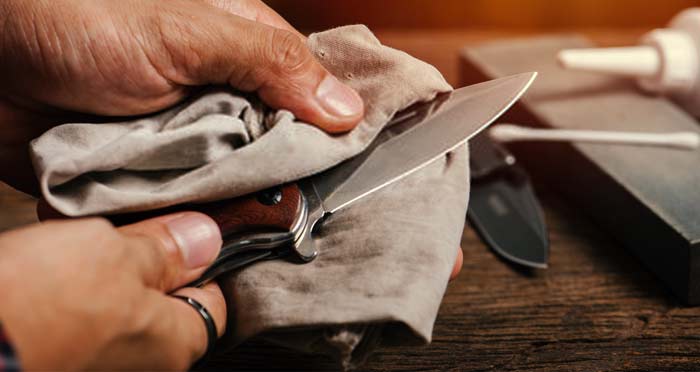If your favorite kitchen knife is made of steel, it’s likely to develop rust spots over time. These unsightly rust stains can appear on the blade, leaving you wondering how to clean old knives. Don’t worry if your cherished knives start to oxidize a bit because there are several ways to get rid of knife rust and restore your knife’s appearance. In this article, we’ll explore how you can transform an old rusty knife into a new one.
Summary
ToggleWhy Clean an Old Knife ?
Cleaning an old knife may seem like a tedious task, but it’s worth it for several reasons. Firstly, a clean and well-maintained knife is safer to use. A dull or rusted knife can slip during cutting, leading to injuries. Moreover, a knife in poor condition doesn’t cut efficiently, making meal preparation more difficult and time-consuming.
Additionally, preserving an old knife can hold sentimental value. Perhaps this knife has been passed down through generations, or it has been used to prepare memorable meals. In such cases, it becomes even more important to restore its shine.
How to Clean the Blades of an Old Knife
Cleaning the blades of an old knife requires careful handling to preserve the quality of the blade. Start by thoroughly washing it with warm water and mild soap, using a soft sponge or a gentle-bristle brush to remove food residues and dirt. If the blade has stubborn stains, a mixture of baking soda and water can be used for polishing. When you’re finished, make sure to dry the blade thoroughly to prevent rust formation, and don’t forget to lightly lubricate it with mineral oil. This will maintain the beauty and functionality of the blade while extending its lifespan.
Cleaning Old Knives with Vinegar :
Step 1:
Fill a large container with white vinegar. Place a sturdy container on your work surface. Choose a container as tall as the length of your blade so that you can fully immerse it. Pour enough white vinegar to reach about 1 inch (2.5 cm) from the top of the container.
If you can’t find a container tall enough, find a shallow container where you can lay your knife instead.
If you’re removing rust from multiple knives, you can use a single container for them, as long as all the knives fit.
Step 2:
Submerge the blade in vinegar to clean old knives. Take your rusty knife and place it blade-down into the container. Ensure that the rusty part is fully immersed in the vinegar so it can loosen the rust. For example, if the area where the blade meets the handle is rusty, you may need to pour a bit more vinegar to ensure that part is submerged.
If you lay the knife flat in a container, keep in mind that the handle will get wet. It’s not a problem if the handle is made of plastic or metal, but moisture can warp wooden handles over time.
Step 3:
Soak the knife for 5 minutes. Set a timer to give the vinegar a chance to dissolve the rust from the knife blade. If you’re soaking a knife with a wooden handle, it’s important not to leave it soaking longer, as the handle could crack.
The vinegar odor is strong, so you can open a window to ventilate the area while you soak the knife.
Step 4:
Rub the blade with a sponge or a toothbrush. Remove the knife from the vinegar and bring it to your sink. Gently rub a sponge or an old toothbrush on the area that was rusted. If you still see stubborn rust spots that won’t come off, sprinkle some baking soda on the blade and scrub it again with a wet sponge or toothbrush.
For really tough rust stains, take a piece of steel wool and rub it back and forth on the blade.
Step 5:
Rinse the old knife and dry it completely. Run cold water over the blade and handle to remove rust particles. Then, thoroughly wipe both sides of the blade with a soft, dry cloth to remove all moisture.
It’s essential to keep the blade dry to prevent the knife from rusting again, and don’t forget to lightly coat it with mineral oil to protect it.
How to Clean a Blackened Steel Knife ?
Cleaning a blackened steel knife can be a bit trickier due to the natural patina that forms on the blade. To restore its shine, start by washing it with warm water and mild soap to remove food residues. Then, use a paste made of baking soda and water to gently rub the blade in circular motions, making sure not to scratch the surface. The patina can add character to your knife, so it’s best not to remove it completely but to clean it lightly to regain its shine. Once the cleaning is done, dry the blade thoroughly and apply a thin layer of mineral oil to protect it from rust and maintain its distinctive patina.
Cleaning Old Knives with Lemons and Salt :
Step 1 :
Cut a lemon in half and rub it on the rusty blade. Place a lemon on a cutting board and cut it in half to get two halves. Take the cut side of one half and rub it carefully back and forth on one side of the knife blade. Turn the knife over and repeat the process on the other side of the blade if it’s also rusty.
Step 2 :
The knife should be rubbed with a sponge to loosen some rust. After you’ve rubbed the lemon on the blade, set the lemon half aside and moisten a sponge. Apply pressure while rubbing the sponge carefully back and forth on the knife blade.
If you’re using a rectangular sponge, try folding it in half over the blunt edge of the knife blade. Pinch the sides of the sponge as you slide it up and down the blade.
Step 3 :
Dip one half of the lemon in salt and use it to rub the blade. Pour salt into a small dish and dip one half of the lemon into it so that the salt sticks to the cut side. Then, rub the rusty areas of the blade until the salt dissolves.
You can use any type of salt you have, such as table salt or kosher salt.
Salt is abrasive, so it can remove rust from the surface of the knife blade.
Step 4 :
Wash the knife with soapy water. Take the knife to your sink and run cold water over it to rinse off the lemon juice and salt. Then, use a soapy washcloth to carefully wipe the blade before rinsing it again with cold water.
Be very careful when washing a slippery knife. Try not to get soap on the handle so you can hold it securely while washing the blade.
Step 5 :
You should pat the knife dry and then dry it with a soft cloth. Run cold water to wash off the soap particles and water from the blade. Then, dry the clean blade thoroughly with a non-scratching soft cloth and store it in a dry place.
To further protect your knife from rust, lightly coat it with vegetable oil if it’s a kitchen knife or machine oil if it’s a pocket or hunting knife.
How to Remove Rust from an Old Knife ?
To remove rust from an old knife, follow a simple yet effective procedure. First, fill a container with white vinegar and submerge the rusty blade in the solution. Let it soak for a few hours or even overnight. The vinegar is acidic and will help loosen the rust. After soaking, use a soft-bristle brush or a sponge to gently scrub the blade, being careful not to scratch the surface. The loosened rust should come off easily. Once you’ve removed the rust, be sure to thoroughly dry the blade to prevent it from rusting again, and don’t forget to coat it with a thin layer of mineral oil to protect it. This process should restore the shine to your old knife by removing the rust and making it safe to use.
Using a Rust Eraser Tool :
Step 1 :
Purchase a rust eraser made of polishing compound and plastic. Look for a rust eraser at your local hardware store, kitchen supply store, or online. This small square or rectangular eraser is flexible like a standard eraser but contains gritty materials like silicon carbide that grind rust off metal.
Rust erasers come in different grits, so choose one based on the amount of rust on your knife. For example, if there are just a few rust spots, choose a fine-grit eraser, or go with a medium-grit eraser for a more rusted knife.
Step 2 :
Rub the rust eraser firmly on the knife blade from left to right. Look at the surface of the knife to see the fine metal lines that make up the grain of the blade. Place the eraser on a rusted area and rub back and forth in the same direction as these lines. Rub the eraser on the blade for 5 to 10 minutes, depending on the extent of rust on your knife. Repeat this process for the other side of the knife if it’s rusty.
The grain forms when the metal is heated and rolled to make the blade.
Apply firm pressure when erasing to remove a deeper layer of rust.
Step 3 :
Wipe the knife with a soft cloth. This will remove rust particles, eraser bits, and any dirt that was on the knife. Then, check the blade for any signs of rust. If you still see rust spots, rub the eraser on them for a few more minutes before wiping the knife again.
Step 4 :
Rub oil on both sides of the knife blade to protect it from rust. Once the knife is dry after cleaning, protect it from moisture. Place a drop of vegetable or cooking oil on one side of the blade and run a clean cloth over the entire surface. Then, spread another drop of oil on the other side of the knife. If you’re working with a folding pocket or hunting knife, use a knife oil or lubricant.
If you have a folding pocket or hunting knife, the knife oil or lubricant keeps the folding mechanism greased so it doesn’t close from rust. You can buy knife oil or lubricant at most hunting and outdoor stores.
Regular Maintenance
Once your old knife is clean and sharp, it’s essential to maintain it regularly to extend its lifespan. Here are some tips for the ongoing maintenance of your knives :
- Clean them immediately after use : Avoid leaving food residues or moisture on the blade.
- Wipe them dry properly : Make sure to dry knives thoroughly after washing to prevent rust.
- Proper storage : Store knives in a knife block or on a magnetic strip to avoid contact between the blades.
- Regular sharpening : Use a sharpener or sharpening stone regularly to maintain blade sharpness.
Conclusion
In conclusion, cleaning an old knife may seem like a daunting task, but it’s worth it to ensure your safety and preserve the functionality of this valuable tool. By following the steps above, you can restore the shine to your knife and extend its lifespan, whether it’s a family heirloom or a faithful companion in your kitchen. Remember that regular maintenance is key to keeping your knives in perfect condition.
.

